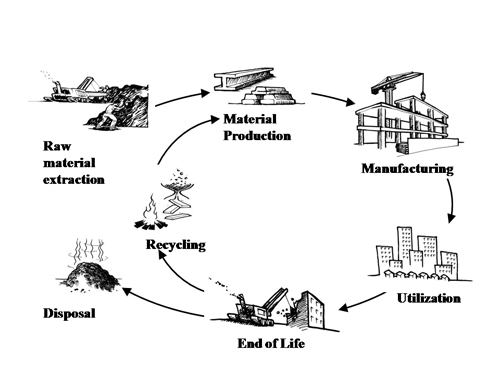
Life Cycle Assessment

A methodology over the whole life cycle
Life Cycle Assessment (LCA) is a systematic analysis of the ecological impact of a product, process, or service over its entire life journey »from the cradle to the grave.« This covers all environmental impacts arising during production, the usage phase, and disposal, as well as the connected upstream and downstream processes such as the extraction and production of raw materials, auxiliaries, or fuels. Life Cycle Assessment can be used as a tool for ecologically oriented decisions. It serves the development and improvement of products. This method is also used in strategic planning, in political policymaking processes, and for marketing. Life Cycle Assessment is an element of Life Cycle Engineering and is standardized in DIN EN ISO 14040/44.
The basic procedure for carrying out a Life Cycle Assessment on the one hand comprises analysis of the material and energy flows of an overall product system, including all processes involved over the entire life journey of a product; and on the other hand the systematic registration of emissions in air, water, and soil, and of resources derived from nature that are registered in a so-called Life Cycle Inventory. Potential ecological effects such as the greenhouse effect, summer smog, acidification, overfertilization etc. are then evaluated in the course of an »impact assessment.«
A Life Cycle Assessment is subdivided into four phases:
- Determining the goal and scope of the investigation
The first stage of the Life Cycle Assessment defines the goal and scope of the investigation. This includes for example a definition of the system boundary, the function of the system, and the requirements placed on data quality.
- Life Cycle Inventory (LCI)
The Life Cycle Inventory is a database of all incoming (resources, materials) and outgoing (emissions, waste) substances and energy flows covered in an assessment. - Life Cycle Impact Assessment (LCIA)
In a Life Cycle Impact Assessment the potential ecological impact, and influences on human health and resource availability, are calculated in a software-supported process using the results of the Life Cycle Inventory on the basis of appropriate characterization models.
- Results and interpretation
In this phase, the results of the Life Cycle Inventory and impact assessment are interpreted in terms of the goal and scope of the Life Cycle Assessment.
